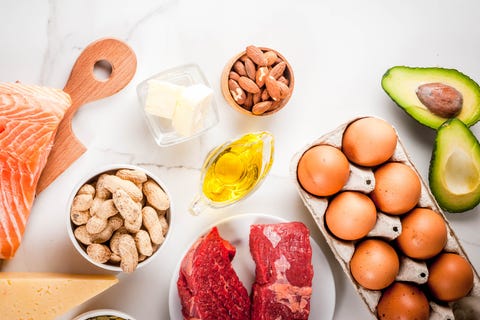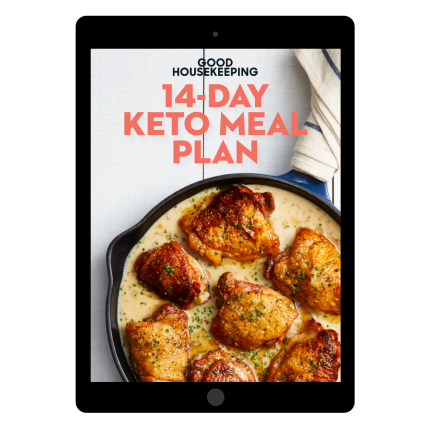Paleo Diet Vs High Fat Low Carb
If you're one of the millions of people who vow to begin a new eating regime on January 1, the potential weight-loss plans are endless. And as you scroll through your Instagram feed, you'll likely to see people touting the "amazing" diet that has shrunk their waistlines, boosted their stamina, and taken years off their appearance.
Two of the trendy diets over the last couple of years include keto and paleo. But before you select your 2019 menu, here's what you need to know about these somewhat similar plans.
Keto Diet 101

Rimma_Bondarenko Getty Images
Otherwise known as the diet Halle Berry, Vanessa Hudgens, Alicia Vikander, and even Tim Tebow swear by, the ketogenic diet is a low-carb, high-fat plan that forces the body into a state of ketosis, a metabolic process produced in the liver in which your body burns fat for energy instead of carbohydrates, says Katherine Brooking, MS, RD, co-founder of Appetite for Health. On a standard keto diet, calories should comprised of a minimum of 70% fat, 20% protein, and 10% carbohydrates.

14-Day Keto Meal Plan: Drop the Pounds with Delicious Recipes
goodhousekeeping.com
$9.99
Since the body's preferred fuel source is sugar (glucose) that comes from carbs (i.e., grains, legumes, fruit), this diet presses the body to use glucose stored in our muscles as glycogen for fuel. "What else happens when we break down muscle glycogen? We lose water weight," explains Good Housekeeping Institute's Nutrition Director Jaclyn London, MS, RD, CDN. "Our muscles store about 3 grams of water for every gram of glycogen, meaning we can lose quite a bit of weight right away when we tap into glycogen stores for fuel. That's why someone who loses weight in 'just one week!' from a low-carb plan is likely losing water weight, not necessarily real weight that stays off over time, but the immediacy can feel motivating at first."
As for the menu, Brooking explains that the keto plan allows dieters to consume fish (salmon, oysters, scallops), meat and poultry (pork, lamb, steak, and yes, bacon!), eggs, nuts, non-starchy vegetables (spinach, broccoli, cauliflower, tomatoes), fats and oils (butter, mayo, avocado oil, ghee) and high-fat dairy (full-fat yogurt, heavy cream, cream cheese, hard and soft cheese). Berries and artificial sweeteners can be eaten sparingly.
This content is imported from {embed-name}. You may be able to find the same content in another format, or you may be able to find more information, at their web site.
"The foods to avoid on keto include most fruits (apples, bananas, peaches, oranges), grains (breads, pastas, cereals, and any foods made with wheat, rice, oats, or corn), legumes (all beans), and anything with added sugar (desserts, honey, cane sugar)," Brooking states. Root veggies (potatoes, carrots, turnips), alcohol, sweetened beverages (juice, soda), sweetened sauces and dips (ketchup, BBQ sauce, some salad dressings), and some oils (canola, soybean, peanut) are on the "no" list — along with any low-fat dairy products.
Paleo Diet 101

Lilechka75 Getty Images
"The paleo diet is meant to resemble the supposed diet of our long-ago, hunter-gatherer ancestors," explains Brooking. "The idea behind it is that our Western pattern of eating is contributing to the rise of chronic illness and obesity."
Also referred to as the Paleolithic diet and caveman diet, this meal plan — which is reportedly a way of eating for Blake Lively and Jessica Biel — focuses on only the foods that were (allegedly) available way back when: poultry (grass-fed meat, fish, seafood), fresh fruits and veggies, eggs, nuts, seeds, and plant-based oils (such as olive, walnut, flaxseed, macadamia, avocado, coconut).
The foods not allowed on this plan include legumes (peanuts, beans, lentils, tofu), grains, dairy, refined sugar, salt, artificial sweeteners, anything processed, and alcohol. And there's no need to count calories or figure out proper percentages. (Do you think the cavewomen were keeping track of their caloric intake?) The diet promotes eating whole foods until you're satisfied.
The Pros and Cons of Keto
The keto diet has a scientific background — but not for weight loss. "Some evidence has found that a keto diet can be effective for patients with epilepsy," Brooking says. In fact, the Epilepsy Foundation promotes the ketogenic diet as a way to help control seizures — and it's usually recommended for children who have failed to respond to prescription treatments.
London adds that she found it hard to believe the keto plan was trending as the latest weight-loss fad since it was prescribed to pediatric patients during the time she worked in a hospital. "It was used as an absolute last resort for families who felt otherwise hopeless in the face of a neurological disease, and under strict medical supervision," she says.
Eating less carbs can be a good thing. People who follow the typical Western diet tend to consume more than the daily recommended amount of carbohydrates (about half of our calories per day, where at least half of these grains derive from whole grains, according to the 2015-2020 USDA Dietary Guidelines for Americans).
However, nearly erasing carbs from an eating plan may be too drastic. "This would be a hard adjustment for most Americans, making the standard keto plan difficult for many to stick with," Brooking says.
Along with some unpleasant side effects (like constipation, crabbiness, lightheadedness, nausea, fatigue, and bad breath), Brooking also points to the fat content in this eating regime. "Keto does not emphasize healthy fats, and we know that foods high in saturated (such as butter, cheese, and red meat) can increase the risk of heart disease," she says.
As for the weight loss, it tends to be short-lived. "The same reasons why we see immediate weight loss on carb-restricted diets is the same reason why we see immediate weight gain after adding a seemingly harmless sandwich back into the mix: The water weight comes back instantly with glycogen storage," London says.
The Pros and Cons of Paleo
Unlike keto, Brooking gives a thumbs up to the back-to-basics approach in this plan. "The pros of paleo are that it focuses on increasing intake of whole foods, all fruits and vegetables, lean proteins, and healthy fats while decreasing consumption of processed foods, sugar, and salt," she says.
Proponents of paleo claim that it can reduce inflammation, increase energy, help with weight loss, stabilize blood sugar, and even reduce the risk of chronic diseases, but the majority of science doesn't agree with all of these assertions. The jury is still out on whether or not the paleo diet can have long-term benefits for people with type 2 diabetes and research published The American Journal of Clinical Nutrition states this dietary plan overall "still lacks evidence."
"When it comes to scientific backing, there is virtually none to support the paleo diet," London says. "The average lifespan of a hunter-gatherer was about 30 years (lovely, huh?)."
As with the keto plan, London and Brooking are not in favor of nixing grains, dairy, and legumes from the diet. "Despite what paleo advocates claim, these foods are healthful and are good sources of fiber, vitamins, and minerals," Brooking says.
And London adds: "My biggest gripe with paleo is that it's generally nutritious, but the model loses me in the elimination factor. Legumes are truly one of the most nutritious foods you can eat, so if you do want a structured plan, you're better off with a modified approach to paleo that at minimum incorporates legumes for additional protein, calcium, and fiber. Even better: Mediterranean diets, which will give you back the 100% whole grains and low-fat dairy too."
The Bottom Line
Both registered dieticians find downsides with the keto and paleo plans and feel that eliminating foods that contain essential nutrients — and, in the case of the keto diet, adding in foods that are high in saturated fat — all in the name of weight loss does not equate to a healthy diet.
"To make real, long-term changes, we can't rely on restriction," London says. "We have to approach health and weight loss with an understanding of our own lifestyle, and shift toward healthier eating habits through behavior changes that last a lifetime."
Since eating preferences and dietary needs vary from person to person, it's advised to check with your doctor before starting any new weight-loss program.
Amy Capetta Amy Capetta has been writing health and lifestyle articles for over 15 years.
This content is created and maintained by a third party, and imported onto this page to help users provide their email addresses. You may be able to find more information about this and similar content at piano.io
Paleo Diet Vs High Fat Low Carb
Source: https://www.goodhousekeeping.com/health/diet-nutrition/a25415613/paleo-vs-keto-diet/

0 komentar:
Posting Komentar